An Analysis of Breach of Duty in the Law of Negligence
VerifiedAdded on 2022/09/01
|7
|1195
|11
Essay
AI Summary
This essay provides an in-depth analysis of breach of duty within the framework of negligence law. It begins by defining breach of duty and its relationship to the standard of care, emphasizing the objective test used in legal proceedings. The essay explores how the objective test may vary depending on the specific circumstances of the case, providing examples such as the case of an amateur soccer player. The discussion then shifts to various factors considered by courts when determining whether a defendant has met the required standard of care, including the probability and gravity of injury, the cost of prevention, and the efficacy of the defendant's conduct. The essay also delves into the maxim 'res ipsa loquitur', examining its application in personal injury law and outlining the conditions necessary for its invocation. The essay concludes with a review of relevant case law, including Vaughan vs. Menlove, Blake vs. Galloway, and O’Connor vs. The Pennine Acute Hospitals NHS Trust, to illustrate the practical application of these legal principles. The assignment offers a comprehensive overview of breach of duty and its implications in the legal system.
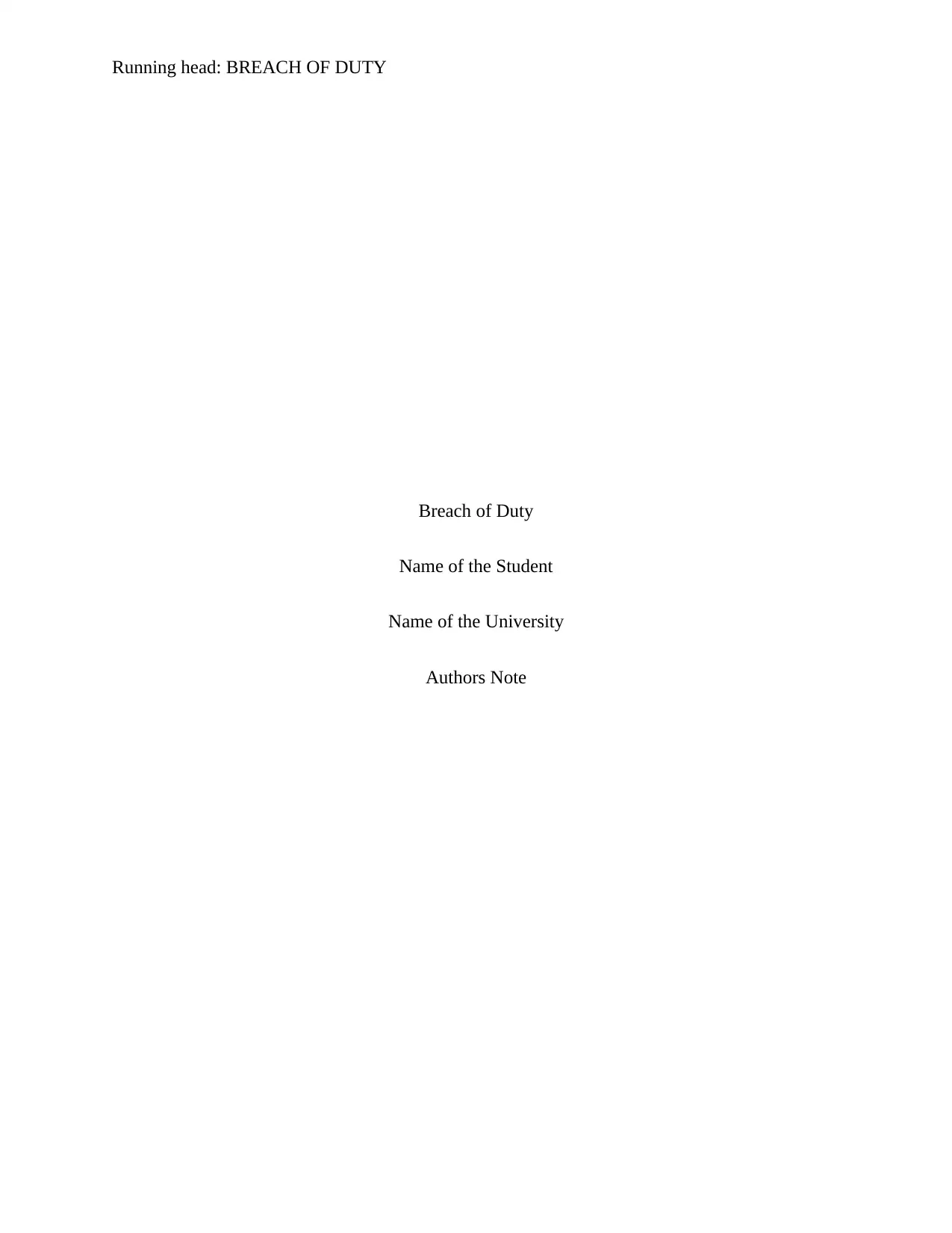
Running head: BREACH OF DUTY
Breach of Duty
Name of the Student
Name of the University
Authors Note
Breach of Duty
Name of the Student
Name of the University
Authors Note
Paraphrase This Document
Need a fresh take? Get an instant paraphrase of this document with our AI Paraphraser
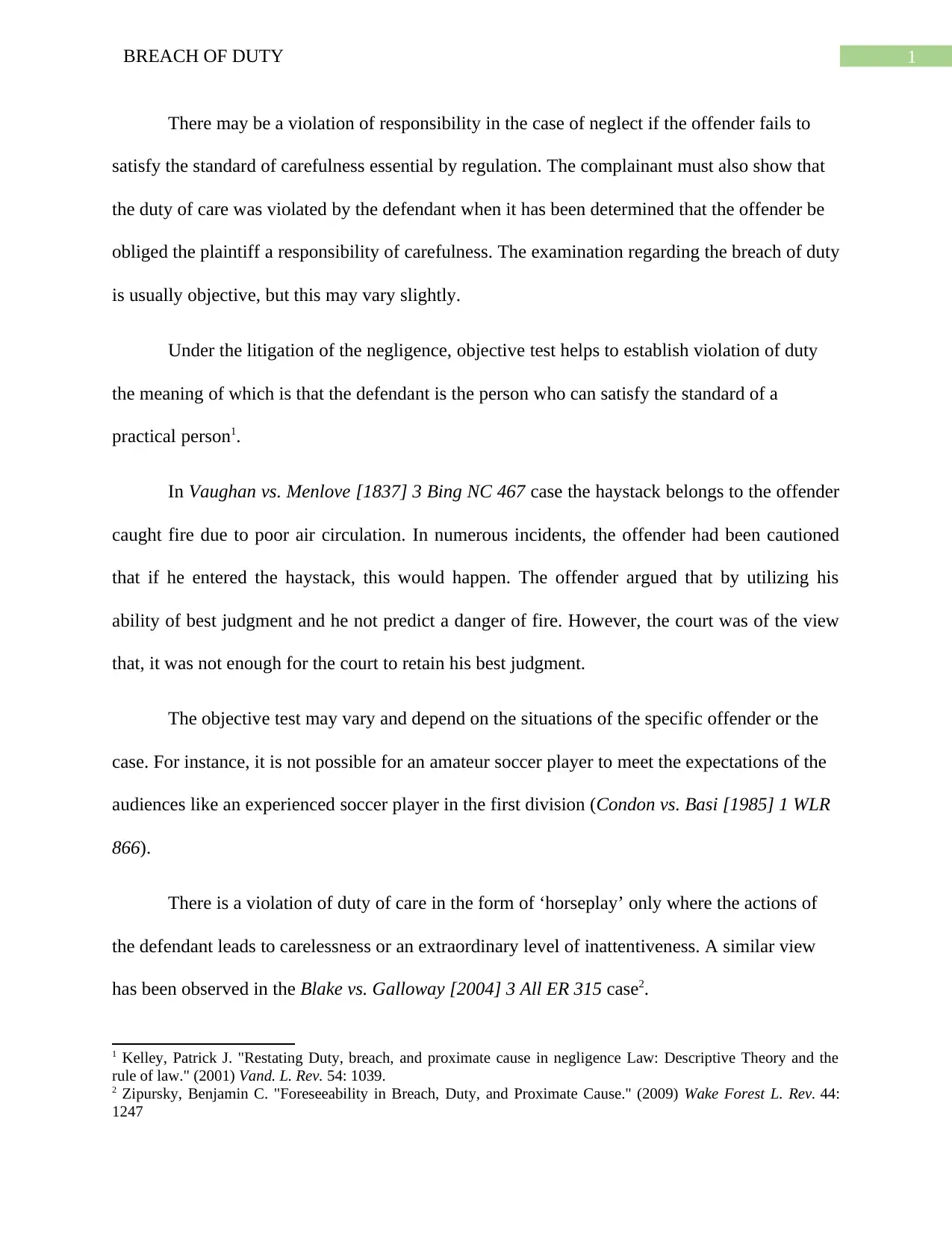
1BREACH OF DUTY
There may be a violation of responsibility in the case of neglect if the offender fails to
satisfy the standard of carefulness essential by regulation. The complainant must also show that
the duty of care was violated by the defendant when it has been determined that the offender be
obliged the plaintiff a responsibility of carefulness. The examination regarding the breach of duty
is usually objective, but this may vary slightly.
Under the litigation of the negligence, objective test helps to establish violation of duty
the meaning of which is that the defendant is the person who can satisfy the standard of a
practical person1.
In Vaughan vs. Menlove [1837] 3 Bing NC 467 case the haystack belongs to the offender
caught fire due to poor air circulation. In numerous incidents, the offender had been cautioned
that if he entered the haystack, this would happen. The offender argued that by utilizing his
ability of best judgment and he not predict a danger of fire. However, the court was of the view
that, it was not enough for the court to retain his best judgment.
The objective test may vary and depend on the situations of the specific offender or the
case. For instance, it is not possible for an amateur soccer player to meet the expectations of the
audiences like an experienced soccer player in the first division (Condon vs. Basi [1985] 1 WLR
866).
There is a violation of duty of care in the form of ‘horseplay’ only where the actions of
the defendant leads to carelessness or an extraordinary level of inattentiveness. A similar view
has been observed in the Blake vs. Galloway [2004] 3 All ER 315 case2.
1 Kelley, Patrick J. "Restating Duty, breach, and proximate cause in negligence Law: Descriptive Theory and the
rule of law." (2001) Vand. L. Rev. 54: 1039.
2 Zipursky, Benjamin C. "Foreseeability in Breach, Duty, and Proximate Cause." (2009) Wake Forest L. Rev. 44:
1247
There may be a violation of responsibility in the case of neglect if the offender fails to
satisfy the standard of carefulness essential by regulation. The complainant must also show that
the duty of care was violated by the defendant when it has been determined that the offender be
obliged the plaintiff a responsibility of carefulness. The examination regarding the breach of duty
is usually objective, but this may vary slightly.
Under the litigation of the negligence, objective test helps to establish violation of duty
the meaning of which is that the defendant is the person who can satisfy the standard of a
practical person1.
In Vaughan vs. Menlove [1837] 3 Bing NC 467 case the haystack belongs to the offender
caught fire due to poor air circulation. In numerous incidents, the offender had been cautioned
that if he entered the haystack, this would happen. The offender argued that by utilizing his
ability of best judgment and he not predict a danger of fire. However, the court was of the view
that, it was not enough for the court to retain his best judgment.
The objective test may vary and depend on the situations of the specific offender or the
case. For instance, it is not possible for an amateur soccer player to meet the expectations of the
audiences like an experienced soccer player in the first division (Condon vs. Basi [1985] 1 WLR
866).
There is a violation of duty of care in the form of ‘horseplay’ only where the actions of
the defendant leads to carelessness or an extraordinary level of inattentiveness. A similar view
has been observed in the Blake vs. Galloway [2004] 3 All ER 315 case2.
1 Kelley, Patrick J. "Restating Duty, breach, and proximate cause in negligence Law: Descriptive Theory and the
rule of law." (2001) Vand. L. Rev. 54: 1039.
2 Zipursky, Benjamin C. "Foreseeability in Breach, Duty, and Proximate Cause." (2009) Wake Forest L. Rev. 44:
1247
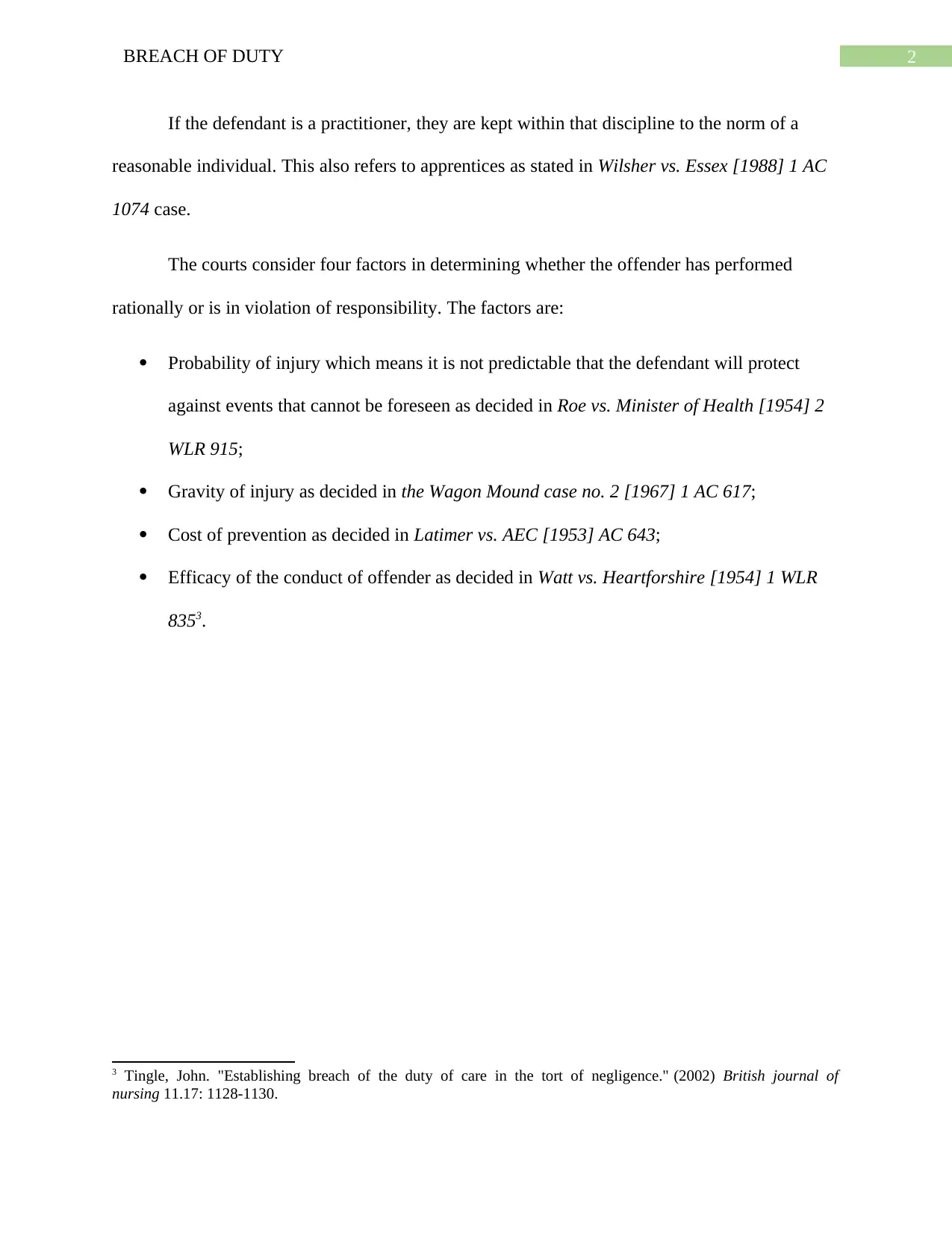
2BREACH OF DUTY
If the defendant is a practitioner, they are kept within that discipline to the norm of a
reasonable individual. This also refers to apprentices as stated in Wilsher vs. Essex [1988] 1 AC
1074 case.
The courts consider four factors in determining whether the offender has performed
rationally or is in violation of responsibility. The factors are:
Probability of injury which means it is not predictable that the defendant will protect
against events that cannot be foreseen as decided in Roe vs. Minister of Health [1954] 2
WLR 915;
Gravity of injury as decided in the Wagon Mound case no. 2 [1967] 1 AC 617;
Cost of prevention as decided in Latimer vs. AEC [1953] AC 643;
Efficacy of the conduct of offender as decided in Watt vs. Heartforshire [1954] 1 WLR
8353.
3 Tingle, John. "Establishing breach of the duty of care in the tort of negligence." (2002) British journal of
nursing 11.17: 1128-1130.
If the defendant is a practitioner, they are kept within that discipline to the norm of a
reasonable individual. This also refers to apprentices as stated in Wilsher vs. Essex [1988] 1 AC
1074 case.
The courts consider four factors in determining whether the offender has performed
rationally or is in violation of responsibility. The factors are:
Probability of injury which means it is not predictable that the defendant will protect
against events that cannot be foreseen as decided in Roe vs. Minister of Health [1954] 2
WLR 915;
Gravity of injury as decided in the Wagon Mound case no. 2 [1967] 1 AC 617;
Cost of prevention as decided in Latimer vs. AEC [1953] AC 643;
Efficacy of the conduct of offender as decided in Watt vs. Heartforshire [1954] 1 WLR
8353.
3 Tingle, John. "Establishing breach of the duty of care in the tort of negligence." (2002) British journal of
nursing 11.17: 1128-1130.
⊘ This is a preview!⊘
Do you want full access?
Subscribe today to unlock all pages.

Trusted by 1+ million students worldwide
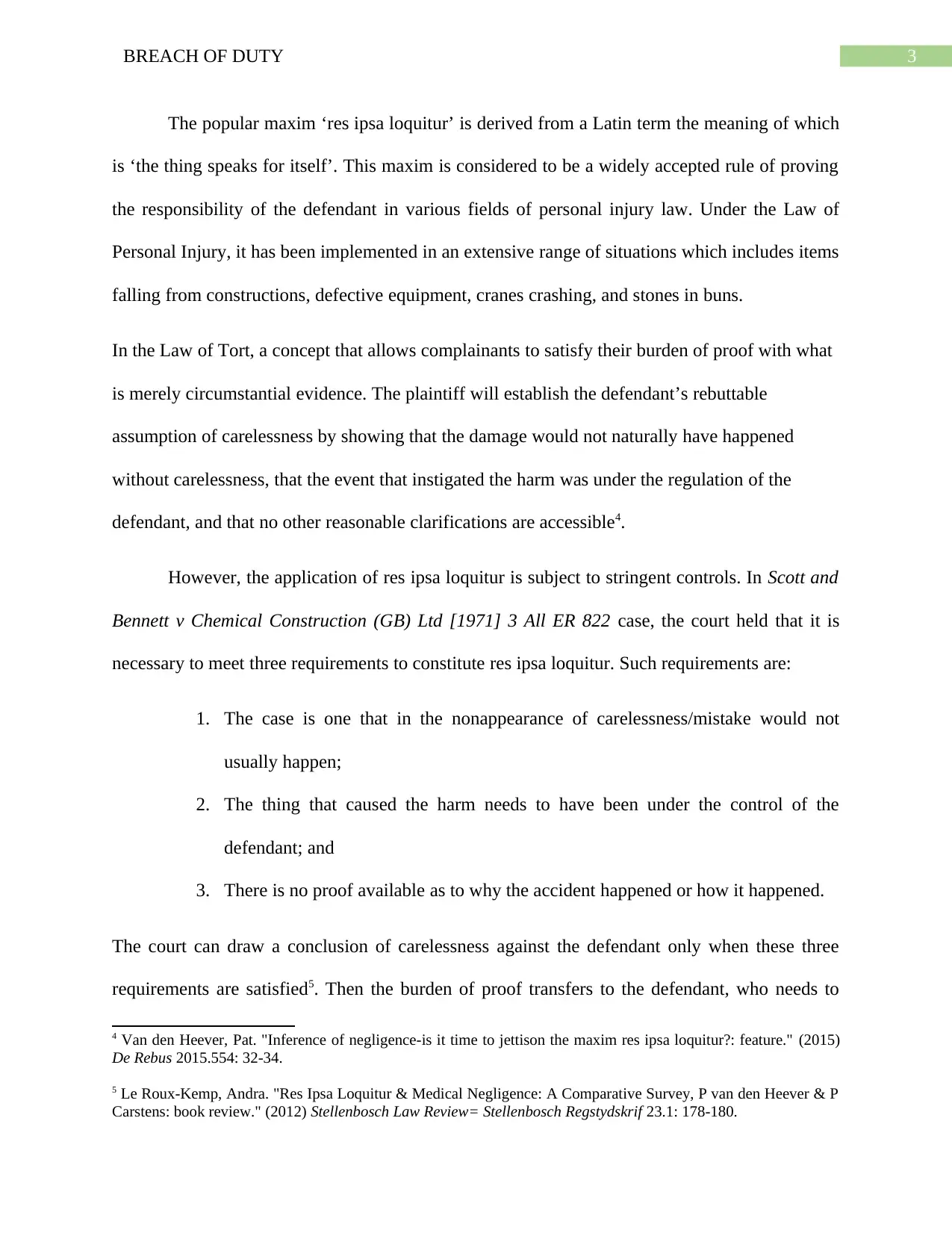
3BREACH OF DUTY
The popular maxim ‘res ipsa loquitur’ is derived from a Latin term the meaning of which
is ‘the thing speaks for itself’. This maxim is considered to be a widely accepted rule of proving
the responsibility of the defendant in various fields of personal injury law. Under the Law of
Personal Injury, it has been implemented in an extensive range of situations which includes items
falling from constructions, defective equipment, cranes crashing, and stones in buns.
In the Law of Tort, a concept that allows complainants to satisfy their burden of proof with what
is merely circumstantial evidence. The plaintiff will establish the defendant’s rebuttable
assumption of carelessness by showing that the damage would not naturally have happened
without carelessness, that the event that instigated the harm was under the regulation of the
defendant, and that no other reasonable clarifications are accessible4.
However, the application of res ipsa loquitur is subject to stringent controls. In Scott and
Bennett v Chemical Construction (GB) Ltd [1971] 3 All ER 822 case, the court held that it is
necessary to meet three requirements to constitute res ipsa loquitur. Such requirements are:
1. The case is one that in the nonappearance of carelessness/mistake would not
usually happen;
2. The thing that caused the harm needs to have been under the control of the
defendant; and
3. There is no proof available as to why the accident happened or how it happened.
The court can draw a conclusion of carelessness against the defendant only when these three
requirements are satisfied5. Then the burden of proof transfers to the defendant, who needs to
4 Van den Heever, Pat. "Inference of negligence-is it time to jettison the maxim res ipsa loquitur?: feature." (2015)
De Rebus 2015.554: 32-34.
5 Le Roux-Kemp, Andra. "Res Ipsa Loquitur & Medical Negligence: A Comparative Survey, P van den Heever & P
Carstens: book review." (2012) Stellenbosch Law Review= Stellenbosch Regstydskrif 23.1: 178-180.
The popular maxim ‘res ipsa loquitur’ is derived from a Latin term the meaning of which
is ‘the thing speaks for itself’. This maxim is considered to be a widely accepted rule of proving
the responsibility of the defendant in various fields of personal injury law. Under the Law of
Personal Injury, it has been implemented in an extensive range of situations which includes items
falling from constructions, defective equipment, cranes crashing, and stones in buns.
In the Law of Tort, a concept that allows complainants to satisfy their burden of proof with what
is merely circumstantial evidence. The plaintiff will establish the defendant’s rebuttable
assumption of carelessness by showing that the damage would not naturally have happened
without carelessness, that the event that instigated the harm was under the regulation of the
defendant, and that no other reasonable clarifications are accessible4.
However, the application of res ipsa loquitur is subject to stringent controls. In Scott and
Bennett v Chemical Construction (GB) Ltd [1971] 3 All ER 822 case, the court held that it is
necessary to meet three requirements to constitute res ipsa loquitur. Such requirements are:
1. The case is one that in the nonappearance of carelessness/mistake would not
usually happen;
2. The thing that caused the harm needs to have been under the control of the
defendant; and
3. There is no proof available as to why the accident happened or how it happened.
The court can draw a conclusion of carelessness against the defendant only when these three
requirements are satisfied5. Then the burden of proof transfers to the defendant, who needs to
4 Van den Heever, Pat. "Inference of negligence-is it time to jettison the maxim res ipsa loquitur?: feature." (2015)
De Rebus 2015.554: 32-34.
5 Le Roux-Kemp, Andra. "Res Ipsa Loquitur & Medical Negligence: A Comparative Survey, P van den Heever & P
Carstens: book review." (2012) Stellenbosch Law Review= Stellenbosch Regstydskrif 23.1: 178-180.
Paraphrase This Document
Need a fresh take? Get an instant paraphrase of this document with our AI Paraphraser
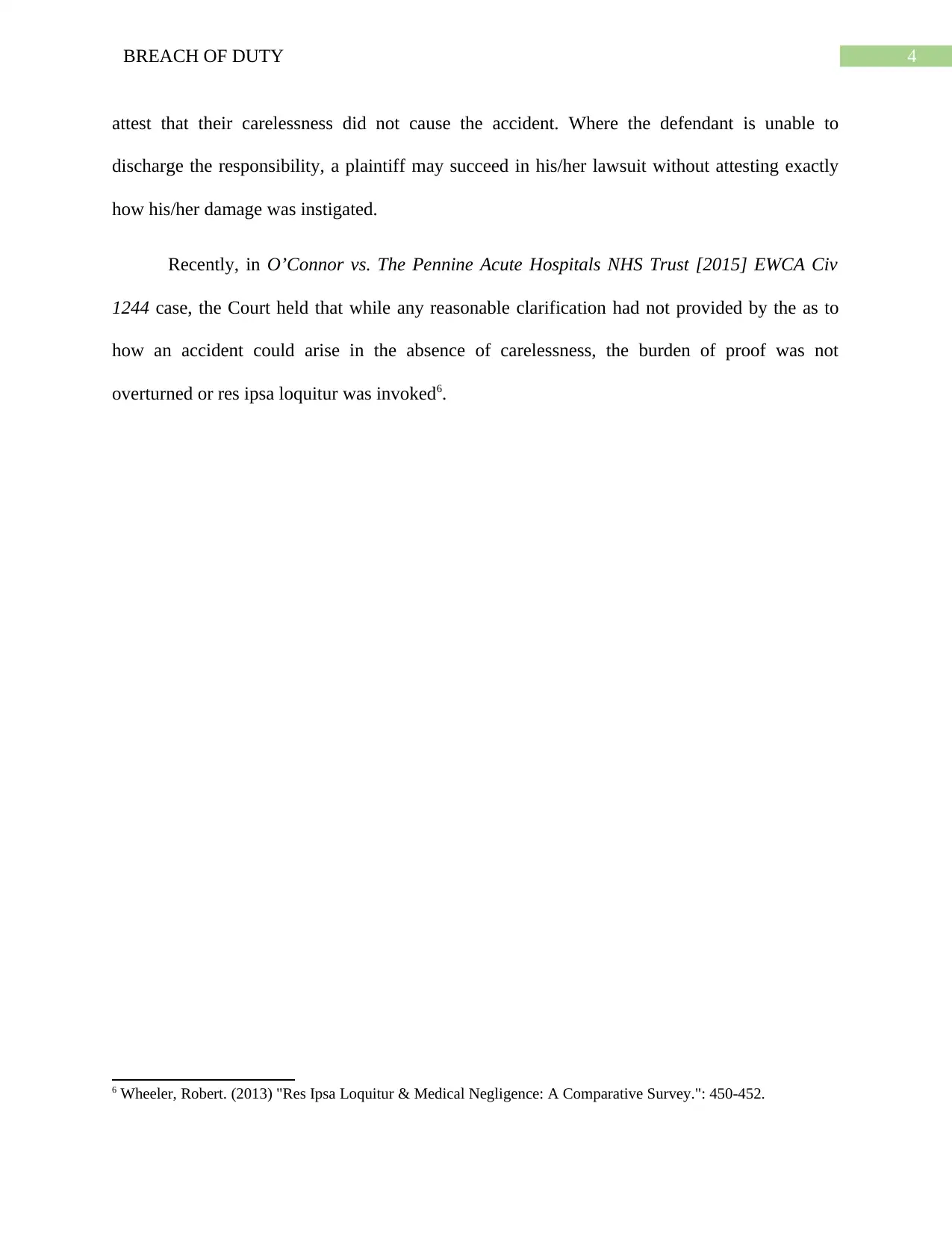
4BREACH OF DUTY
attest that their carelessness did not cause the accident. Where the defendant is unable to
discharge the responsibility, a plaintiff may succeed in his/her lawsuit without attesting exactly
how his/her damage was instigated.
Recently, in O’Connor vs. The Pennine Acute Hospitals NHS Trust [2015] EWCA Civ
1244 case, the Court held that while any reasonable clarification had not provided by the as to
how an accident could arise in the absence of carelessness, the burden of proof was not
overturned or res ipsa loquitur was invoked6.
6 Wheeler, Robert. (2013) "Res Ipsa Loquitur & Medical Negligence: A Comparative Survey.": 450-452.
attest that their carelessness did not cause the accident. Where the defendant is unable to
discharge the responsibility, a plaintiff may succeed in his/her lawsuit without attesting exactly
how his/her damage was instigated.
Recently, in O’Connor vs. The Pennine Acute Hospitals NHS Trust [2015] EWCA Civ
1244 case, the Court held that while any reasonable clarification had not provided by the as to
how an accident could arise in the absence of carelessness, the burden of proof was not
overturned or res ipsa loquitur was invoked6.
6 Wheeler, Robert. (2013) "Res Ipsa Loquitur & Medical Negligence: A Comparative Survey.": 450-452.
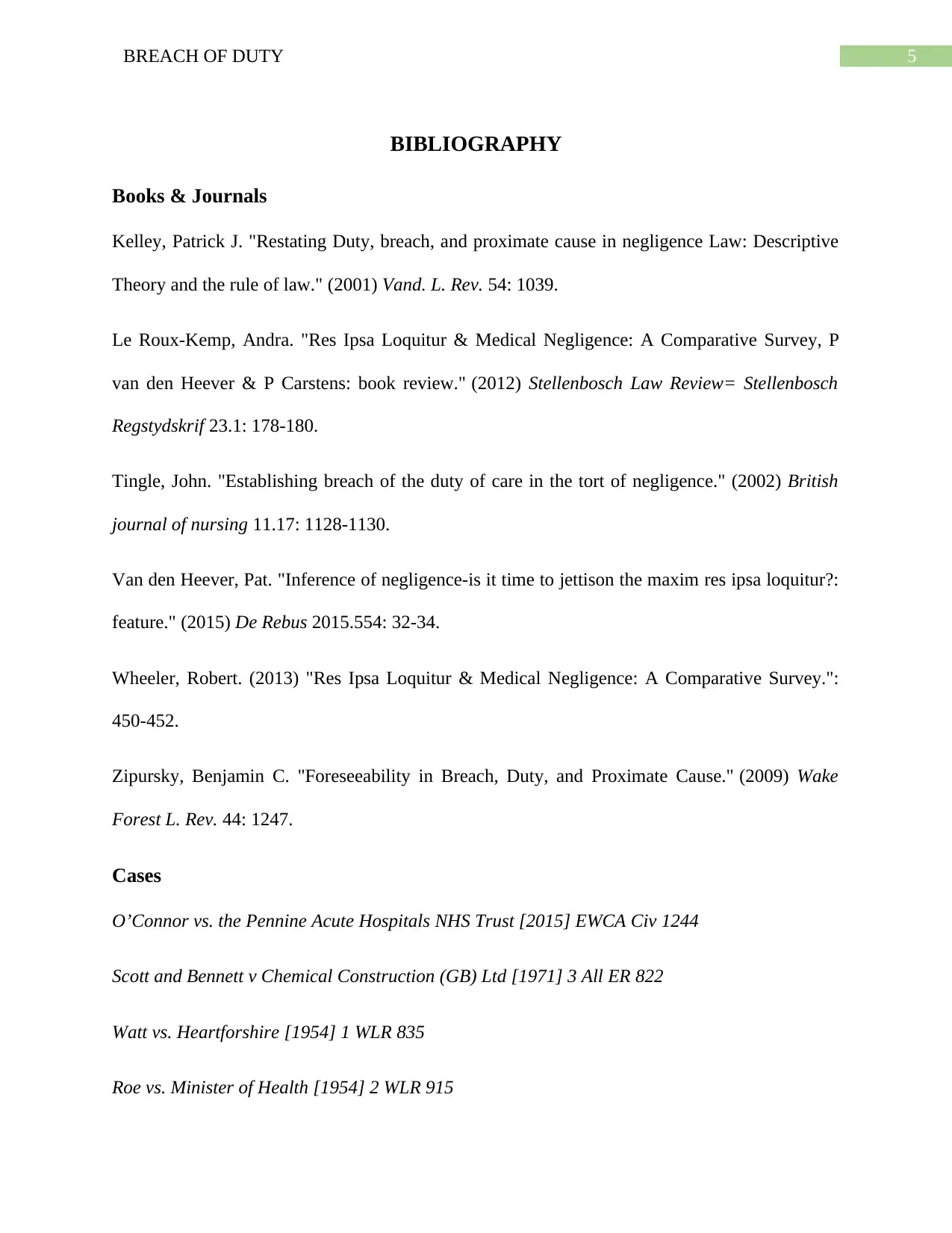
5BREACH OF DUTY
BIBLIOGRAPHY
Books & Journals
Kelley, Patrick J. "Restating Duty, breach, and proximate cause in negligence Law: Descriptive
Theory and the rule of law." (2001) Vand. L. Rev. 54: 1039.
Le Roux-Kemp, Andra. "Res Ipsa Loquitur & Medical Negligence: A Comparative Survey, P
van den Heever & P Carstens: book review." (2012) Stellenbosch Law Review= Stellenbosch
Regstydskrif 23.1: 178-180.
Tingle, John. "Establishing breach of the duty of care in the tort of negligence." (2002) British
journal of nursing 11.17: 1128-1130.
Van den Heever, Pat. "Inference of negligence-is it time to jettison the maxim res ipsa loquitur?:
feature." (2015) De Rebus 2015.554: 32-34.
Wheeler, Robert. (2013) "Res Ipsa Loquitur & Medical Negligence: A Comparative Survey.":
450-452.
Zipursky, Benjamin C. "Foreseeability in Breach, Duty, and Proximate Cause." (2009) Wake
Forest L. Rev. 44: 1247.
Cases
O’Connor vs. the Pennine Acute Hospitals NHS Trust [2015] EWCA Civ 1244
Scott and Bennett v Chemical Construction (GB) Ltd [1971] 3 All ER 822
Watt vs. Heartforshire [1954] 1 WLR 835
Roe vs. Minister of Health [1954] 2 WLR 915
BIBLIOGRAPHY
Books & Journals
Kelley, Patrick J. "Restating Duty, breach, and proximate cause in negligence Law: Descriptive
Theory and the rule of law." (2001) Vand. L. Rev. 54: 1039.
Le Roux-Kemp, Andra. "Res Ipsa Loquitur & Medical Negligence: A Comparative Survey, P
van den Heever & P Carstens: book review." (2012) Stellenbosch Law Review= Stellenbosch
Regstydskrif 23.1: 178-180.
Tingle, John. "Establishing breach of the duty of care in the tort of negligence." (2002) British
journal of nursing 11.17: 1128-1130.
Van den Heever, Pat. "Inference of negligence-is it time to jettison the maxim res ipsa loquitur?:
feature." (2015) De Rebus 2015.554: 32-34.
Wheeler, Robert. (2013) "Res Ipsa Loquitur & Medical Negligence: A Comparative Survey.":
450-452.
Zipursky, Benjamin C. "Foreseeability in Breach, Duty, and Proximate Cause." (2009) Wake
Forest L. Rev. 44: 1247.
Cases
O’Connor vs. the Pennine Acute Hospitals NHS Trust [2015] EWCA Civ 1244
Scott and Bennett v Chemical Construction (GB) Ltd [1971] 3 All ER 822
Watt vs. Heartforshire [1954] 1 WLR 835
Roe vs. Minister of Health [1954] 2 WLR 915
⊘ This is a preview!⊘
Do you want full access?
Subscribe today to unlock all pages.

Trusted by 1+ million students worldwide
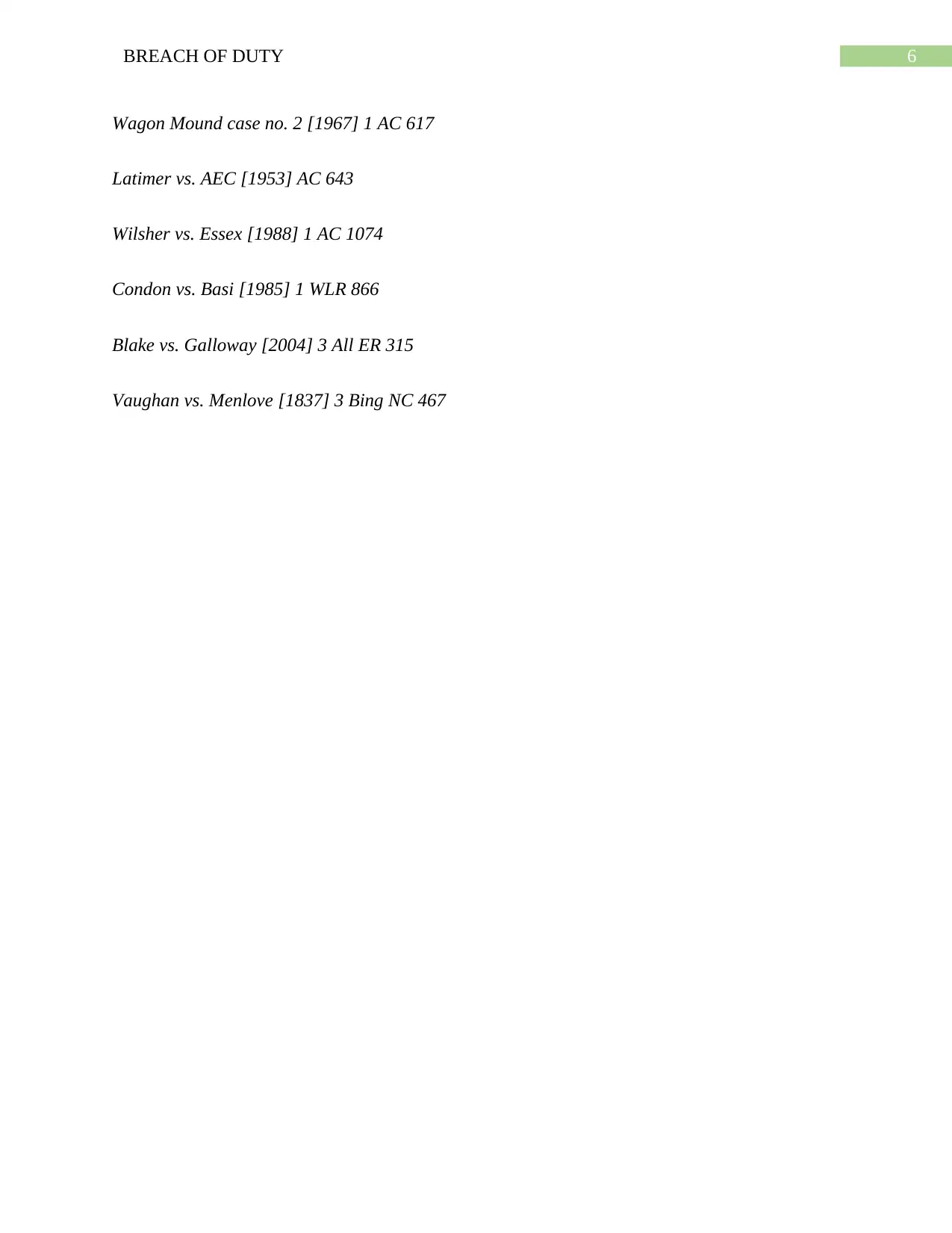
6BREACH OF DUTY
Wagon Mound case no. 2 [1967] 1 AC 617
Latimer vs. AEC [1953] AC 643
Wilsher vs. Essex [1988] 1 AC 1074
Condon vs. Basi [1985] 1 WLR 866
Blake vs. Galloway [2004] 3 All ER 315
Vaughan vs. Menlove [1837] 3 Bing NC 467
Wagon Mound case no. 2 [1967] 1 AC 617
Latimer vs. AEC [1953] AC 643
Wilsher vs. Essex [1988] 1 AC 1074
Condon vs. Basi [1985] 1 WLR 866
Blake vs. Galloway [2004] 3 All ER 315
Vaughan vs. Menlove [1837] 3 Bing NC 467
1 out of 7
Related Documents
Your All-in-One AI-Powered Toolkit for Academic Success.
+13062052269
info@desklib.com
Available 24*7 on WhatsApp / Email
![[object Object]](/_next/static/media/star-bottom.7253800d.svg)
Unlock your academic potential
Copyright © 2020–2025 A2Z Services. All Rights Reserved. Developed and managed by ZUCOL.




